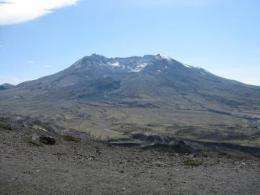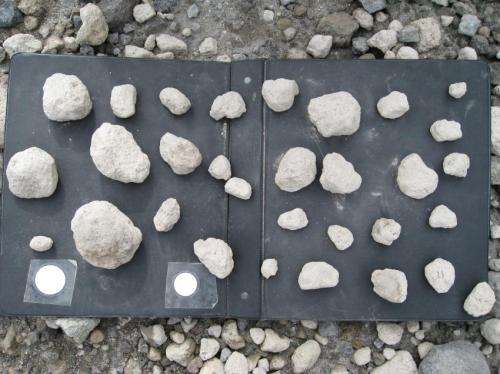This is Mt. St. Helens in Washington. Credit: Josef Dufek
How much ash will be injected into the atmosphere during Earth's next volcanic eruption? Recent eruptions have demonstrated our continued vulnerability to ash dispersal, which can disrupt the aviation industry and cause billions of dollars in economic loss. Scientists widely believe that volcanic particle size is determined by the initial fragmentation process, when bubbly magma deep in the volcano changes into gas-particle flows.
But new Georgia Tech research indicates a more dynamic process where the amount and size of volcanic ash actually depend on what happens afterward, as the particles race toward the surface. Their initial size and source depth, as well as the collisions they endure within the conduit, are the differences between palm-sized pumice that hit the ground and dense ash plumes that jet into the atmosphere and can halt aviation. The findings are published in the current edition of Nature Geoscience.
Assistant Professor Josef Dufek used lab experiments and computer simulations to study particle break-up, known as granular disruption, in volcanic eruptions. His team, which included the University of California, Berkeley's Michael Manga and Ameeta Patel, determined that shallow (approximately 500 meters below the surface) fragmentation levels likely cause abundant, large pumice that are often seen in large volcanic eruptions. If the fragmentation begins a few kilometers underground, the volcano is more likely to emit fine-grained ash.
Georgia Tech Assistant Professor Josef Dufek studied how pumice rocks travel through a volcano. The process affects the size of particles that are released during an eruption. The pictured rocks are from Mt. St. Helens in Washington. Credit: Josef Dufek
"The longer these particles stay in the conduit, the more often they collide with each other," said Dufek, a faculty member in Georgia Tech's School of Earth and Atmospheric Sciences. "These high-energy collisions break the volcanic particles into fractions of their original size. That's why deeper fragmentations produce small particles. Particles that begin closer to the surface with less energy don't have time for as many collisions before they exit the volcano. They stay more intact, are larger and often contained in pyroclastic flows."
The team collected volcanic rock from California's Medicine Lake volcanic deposit for collision experiments. They also used glass spheres because, like glass, pumice is heated and hardens before crystals are able to form. Using a pumice gun that propels volcanic fragments using compressed gases, Dufek and his team determined that particles must collide at a minimum of 30 meters per second to break into larger pieces.
Using numerical simulations, the researchers concluded that large pumice particles (greater than fist size) will not likely remain intact unless the fragmentation is very shallow. Abundant large pumice rocks in a deposit provide an indication of the depth of fragmentation, which may vary over the course of the eruption. Due to the depth and violent nature of the process, scientists have had little record of the depth of the fragmentation process, even though much of the eruptive dynamics and subsequent hazards are determined in this process.
Dufek and his team will next use the research to better understand the dynamics of one of the most rare natural disasters: super volcanoes, which produced the features in Yellowstone National Park.
"We know very little about the eruption processes during super eruptions," said Dufek. "Indications of their fragmentation levels will provide important clues to their eruptive dynamics, allowing us to study them in new ways."
Journal information: Nature Geoscience
Provided by Georgia Institute of Technology




















